Tape recover case study #5 -physical damage with skew signal
One of the most difficult part when it comes to preservation is when the actual media is in bad condition; meaning the actual tape mass is fragile.
Let's have a look at the actual tape to get a proper understanding.
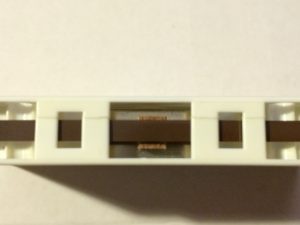
Critical incidents:
-The band mass' color is pretty brown, that indicates the quality is not the most optimal.
-The softpad is harden and particles are falling off really easy.
-The band mass is partially dirty, probably something inside the housing is causing this. Idea would be the paper/plastic cover resting between the actual plastic case and tape mass.
In this case all criteria are checked, meaning this is critical and going to be a rough reading-phase with only a few tests before the tape will get destroyed.
To really understand the error have a look at this image.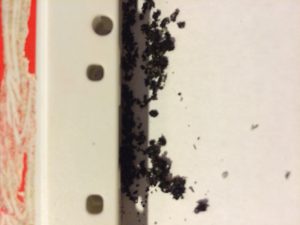
This felt out of the tape by just tapping and drop it down. Nothing you want to have in your datassette. We need to clean this tape to process.
Unfortunately the pictures of whole cleaning process got lost due an error from my side. But don't worry I will make a specific article about this in the near future.
However, I was able to capture the actual "dewrinkle" process.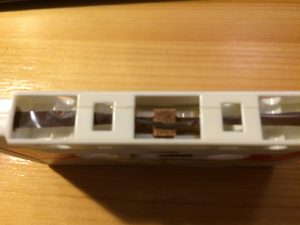
This is really one nasty tape to deal with, I have no idea what happened to the tape, but it looks like an old tapedrive might have caused this. Let's see what some patience and time can do.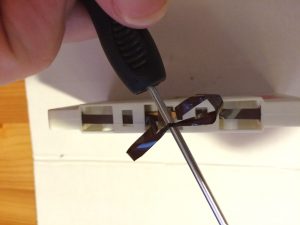
First time to de-tangle the tape mass which is a time consuming work, but there are really no shortcuts to get the job done!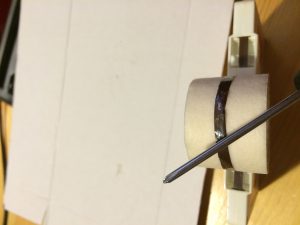
Carefully stretching the wrinkled tape mass over a soft cylinder, applying small pressure from a heated screwdriver. Yes, you need to be extremely careful to not apply too much heat or the tape mass will melt.
The signal analys:
After spending about two days to clean, straighten, patch and trim the band mass. It was now time to extract the data from the tape.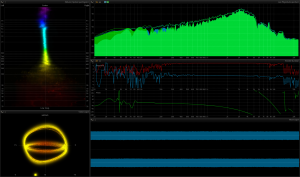
Now this might look fancy and overkill but I find this tool really awesome when it comes to get a perfect overview how the signal is doing.
The method used is called "Flux Audio Signal Analys". It's an effective method to visualize all possible artifacts and corrections.
More info will help get to the correct method/methods faster. Risking limited reading time.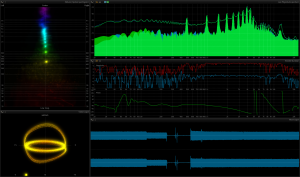
Now things are looking better. We can see the there are several of "Turbo250" Data Segments. The Pulses are pretty straight now.
Meaning the time consuming prework was worth the time to get success.
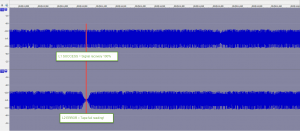
When looking at the two channels we clearly see L1 has a more significant signal compared to L2.
This is because L2 is skewed making the pulses not valid. However we can compensate this by merging L1 and L2.
That way L1 can reconstruct the errors in L2 and in worse case scenario L2 can reconstruct errors in L1.
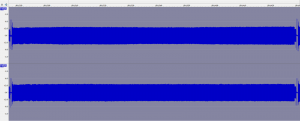
By combining L1 and L2 we get a reliable result.
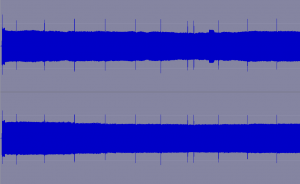
Since I repaired the tape on several places I wanted to make sure my "glued" parts were working.
Accordingly to the briefly signal overview, it seems to be in order. Patience is the key to yet another success.

However, we run into short water and there are some differences in the level of the signal.
I did a few re-reads with different datassette but none of them were able to read the pulses correctly.
But there is a way to get by this problem and one essential way is, "NEVER GIVE UP!".
Signal Analysis part II
At first sight we can see the signal is also inverted, just to make things a bit more complicated.
This might have occurred due the damaged band mass or it was written badly.
To mirror the band mass won't help, because that way it will be read reversed.

To clarify the difference between the reversed pulses and normal pulses.
After some more analysis of the entire signal flow, it was clear everything was in fact inverted.
This was fixed by inverting the pulses and it worked fine.

The final signal flow is starting to look good and we're about to see some results now.
Because I sampled the tape in HF mode using 24-bis resolution we now have the data secured.
Sidenote: Always work in High Frequency mode using 48Khz/96Khz, to get most of the signal.
Since the background or ambient noises can in some case help to restore the signal.

When combining L1+L2 and synchronizing the pulses we have now got a great signal that is pretty much clean too.
Most of the unwanted noises are washed out.

This is the evident signal, showing we now have a correct Turbo250 Data signal! This is what we wanted to have.
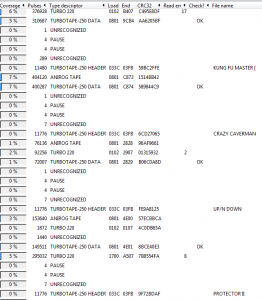
Here is an extract from the complete signal revealing its secrets into a 98% recovered Turbo Tape Cassette.
Eventhough, two files were not successfully recovered I did some deeper analysis to come to the conclusion those files are existing.
and Are known files too. One was a cracked version of "Giana Sisters", released by Network and the other one was "International Karate".
So yes it's possible to make the impossible possible with the right knowledge, understanding, dedication and somehow know what methods to use and use them together with the right tools.
I hope this has been useful for you and it gave you some insights about what "True data archaeology" is all about".
-Xiny6581 10/02-2017-